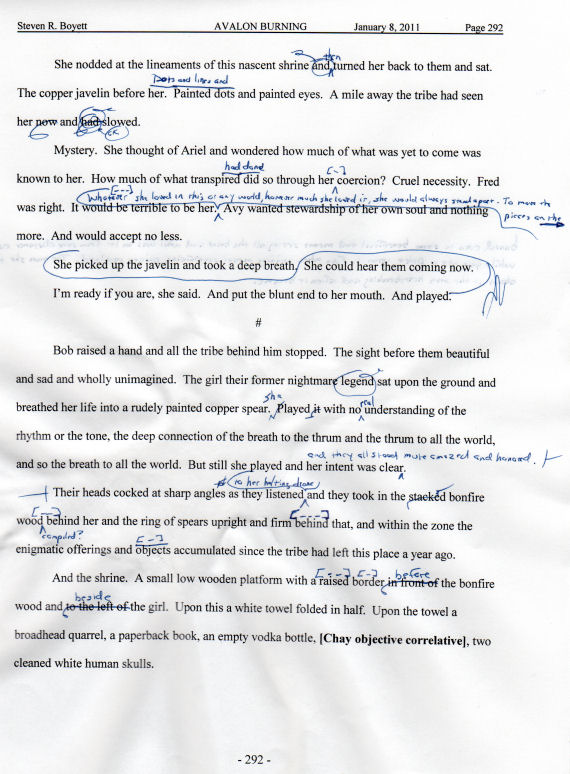When opportunity presents itself in a writing class or workshop, I like to teach a section on revision. I’ve never really seen a class devoted to revision, other than the ones I teach, and it surprises me, as I think revision is where the real writing takes place. And even if you think that first draft is the real creative nugget, it’s still important to know what to look for when you re-read the thing with an understanding that you intend to inflict it upon an unsuspecting world.
For classes, I like to print out a page of first draft onto a transparency sheet and revise with a Sharpie using an overhead projector. But as overhead projectors are becoming fossils in a digital world, I guess I will have to come up with some other way. It’s kind of a weird dynamic when I do this. I mean, I’m supposed to be an authority, teaching starry-eyed writers about Art and The Business, and all like that, and here I am basically standing in front of them in my underwear. Cuz that’s what first draft can look like. I’ve had students actually laugh out loud when they realize that I make some of the same dumb mistakes on first go-round that they do.
But I also think that’s one of the implicit values in the lesson — that professionals aren’t standing on some Olympian height creating perfectly polished prose on the hurling of a single thunderbolt of inspiration (though, okay, yeah, it happens like that sometimes). The idea is to impart the notion that one of the duties of a professional is knowing how to recognize and remove those mistakes, and how to re-read his own stuff with a view toward improving every word that’s there — cutting or expanding, rearranging lines, reordering words, substituting words for the sake of meter, drawing threads of theme and sound and image through the narrative, ensuring naturalistic dialogue, ensuring that the point of the scene is not lost, and much more.
So I thought it would be fun and maybe instructive to talk for a few days about how I revise. I’ll use a marked-up page from Avalon Burning, and I’ll try to explain why I made some corrections the way I did. In my view, all of these decisions are as contributory to the perception of style as the decisions that first put the words on the page. Maybe there’s an element in here that’s too much like a magician revealing how he does his tricks. I don’t know and I don’t care. This shit isn’t magic, it’s work. It’s not just a matter of just tell what happens, it’s a way of looking at language.
Here’s the marked-up page. I’ve revised it even further since, but we don’t have to worry about that now (though it might be fun to show how far I take it, maybe focusing on this one stretch of prose throughout the entire writing process. Hmm. Lemme think about that.). I’ll go over it a piece at a time in subsequent posts. If you think this is about as exciting as watching glaciers drag race, I won’t be insulted if you take a pass.
